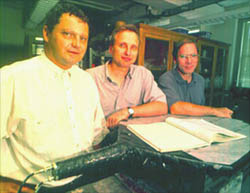by Lance Skelly

Neutrinos are among the most elusive particles known to man, yet these tiny elements have been giving scientists big headaches for many years. In fact the word neutrino, which even sounds small, is an Italian diminutive invented by the scientist Enrico Fermi.
But some University of Alabama physics professors are searching for keys that will unlock the clues surrounding these mysterious, yet fundamental, constituents of nature and their impact on everything from the most distant celestial objects to our understanding of the microcosm.
Neutrinos are electrically neutral, sub-atomic particles, which pass effortlessly through matter. One of the biggest questions on the minds of scientists everywhere from UA to Japan is whether or not these speedy travelers actually possess mass. Of course, the trick to learning more about neutrinos is in actually observing them, and many experiments — from Chicago’s famed Fermi National Accelerator Laboratory, to the polar ice caps of the South Pole — seek to unravel the mysteries of the neutrino.
Drs. Jerome Busenitz, Andreas Piepke, and Ion Stancu, professors in the College of Arts and Sciences’ department of physics and astronomy, are engaged in numerous high profile projects, which are helping them learn more about neutrinos through observation.
Stancu, assistant professor of physics, is currently involved in projects at both the Fermi National Accelerator Laboratory in Chicago and the South Pole. According to him, there are three types of neutrinos — an electron neutrino, a muon neutrino and a tau neutrino. As he explains, if it can be detected that neutrinos “oscillate,” that is if they are able to change from one state, known as a flavor, to another, a non-zero mass has been demonstrated.
“If we find that neutrinos do oscillate, then we know that they have mass. Doing that, however, proves to be quite difficult,” said Stancu. “We are involved in terrestrial experiments in which we manufacture a neutrino beam that has to be as pure as possible. Simply, you take a neutrino of one flavor and go some distance away and you are looking to predict the flux of how many neutrinos you might expect. If you see a reduction, you may conclude that some of them have oscillated away. Or, on the other hand, you look for the appearance of the wrong flavor.”
Some of these experiments are done in huge detectors. And although the detector can’t actually see neutrinos, charged particles can be seen as the result of element collisions. Another experiment Stancu is involved in at the South Pole does not utilize giant detectors, but instead uses ice.
The purpose is to observe high-energy neutrinos from astrophysical point sources. Strings of widely spaced photomultiplier tubes are placed in deep ice through drilled holes in the South Polar ice cap. According to Stancu, high-energy neutrinos coming up through the earth will occasionally interact with the ice and create a muon (an elementary particle in the lepton family); such a muon emits light when passing through the array, and it can be tracked by measuring the arrival times of photons.
Piepke and Busenitz have been actively involved in the KamLAND project. In this project, a 2,500 ton detector built deep underground in a Japanese zinc mine is used. It probes the flux of anti-neutrinos emitted by commercial Japanese nuclear power reactors in order to conclusively test whether or not the observed deficit of neutrinos emitted by the sun is due to neutrino oscillations. This project is a collaborative effort between Japanese researchers and groups from 10 U.S. universities. Piepke is also involved in a new complementary study investigating the so-called neutrino-less double beta decay, only possible if neutrinos carry mass. This is a collaboration with groups from Stanford University, Stanford Linear Accelerator Center and Moscow.
The UA physicists are each also involved in more detailed research that is growing in collaboration and interest among scientists — in a field of science Stancu says is “one the hottest topics discussed and researched today.”
While the results are yet undetermined, it is the uncertainty of the future findings and reactions during experiments that drives researchers such as Piepke. “I take my enjoyment in the fact that we are dealing with nature – an unknown element and area of discovery — and trying to, for the first time, determine how something works and for what reason,” explained Piepke. “Each new project holds a world of possibilities we have not yet discovered. Taking part in this marvelous field of science is exciting in that we are dealing with unknown elements and trying to discover their role in our universe.”